Aloe succotrina
Aloe succotrina Lam.
Family: Asphodelaceae
Common names: fynbos aloe, mountain aloe (Eng.); bergaalwyn (Afr.)
Introduction
Growing high up on the cliff faces and rocky outcrops in the mountains of the Western Cape, this is one of only a few fynbos aloes. It is an attractive aloe that will thrive in fynbos and strandveld gardens.
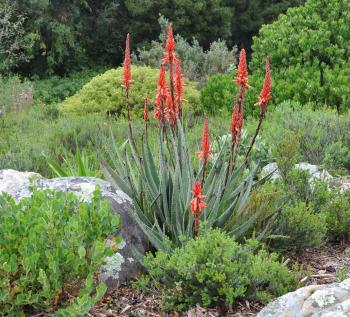
Description
Description
Aloe succotrina is a succulent shrub that can grow up to 1.5 m tall, but usually only grows up to 1 m tall. Solitary specimens do occur, but this aloe is usually found in small to large, dense clumps. Plants are stemless when young, but branching in older specimens and are covered with the remains of older dried leaves. Stems are dichotomously branched and rebranched, forming impenetrable groups.
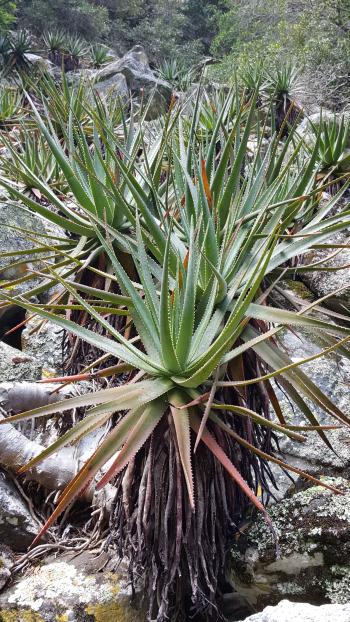
The stiff leaves form dense rosettes and are dull grey-green, with scattered spots. They have firm, triangular, white teeth along their margins, which become smaller towards the leaf base. The leaves are 500 × 100 mm and are ascending, curved and tapering. The purple colour of the old leaves is one of the characteristics of Aloe succotrina that helps to distinguish it between similar looking species.

The flower spike is unbranched and grows up to 1 m high. The inflorescence is a raceme, up to 350 mm long. The dark orange-red, simple, tubular flowers have green tips and are up to 40 mm long and appear in mid-winter, from July to August. They are erect at first, but hang down once they have opened. The fruits ripen in spring, releasing small black seeds.
Aloes are sometimes confused with a number of other plants occurring in South Africa such as Kniphofia, Bulbine and Gasteria, but the two most conspicuous characteristics of aloes are their succulent leaves that are arranged in rosettes, and their tall, usually candle-like inflorescences. Some aloes grow to be trees, such as Aloidendron dichotomum, whereas others are only a few centimeters tall.
Conservation Status
Status
Aloe succotrina is assessed as Least Concern (LC) according to the Red List of South African plants. It has a restricted range in the Western Cape and populations may have declined due to urban development in the past, but there are more than 10 subpopulations remaining that are in a protected national park. Unfortunately, in some areas that are more accessible, plants are collected illegally and overharvested. This has resulted in the decimation of some populations.
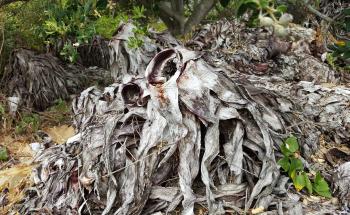
Distribution and habitat
Distribution description
Aloe succotrina is a true fynbos species and always occurs on quartzitic, sandstone rocks and cliffs of the Cape Fold Mountains, in the extreme southwestern Cape. They grow on sheer cliff faces, hills and rock faces and are restricted to the Cape Peninsula, Hangklip and Hermanus areas. In Hermanus, it grows on coastal rocks. In a number of localities, plants are found to grow amongst and between sandstone boulders. The plants grow from sea level to an altitude of 900 m.
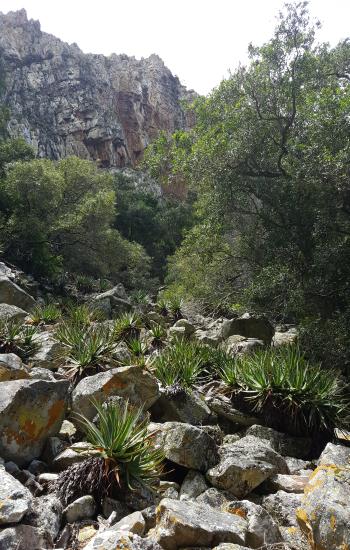
Aloe succotrina grows in dense groups where the contour path reaches its highest point, at the northwestern corner of the natural area of Kirstenbosch National Botanical Garden, below the sheer cliffs of Maclear’s Beacon on Table Mountain. They are also found growing at the Harold Porter NBG, in between rocks, up on the sides of the mountains. It receives winter rainfall and hot dry summers. Plants can be found growing in semi-shaded areas in forests or on sunny cliff faces where they are protected from frost.
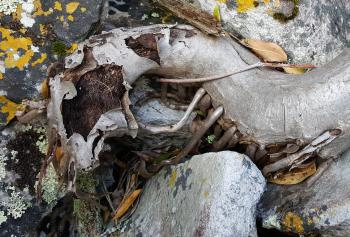
Derivation of name and historical aspects
History
Aloe succotrina has had a very confused history. Early botanical workers assumed that the plant had originated from the Indian Ocean Island of Socotra, which is the largest of several islands, extending eastwards from the Horn of Africa. Succotrina was thought to be the adjectival form of Socotra. For many years the origin of this plant remained a mystery. It is, however, a Cape plant and in 1906, a precise locality at the Cape was recorded.
A second possibility for the choice of name Aloe succotrina, made by O. Dapper in his AFRICA: Naukeurige beschrijvinge der Afrikaensche Gewesten published in 1668, under ‘Het Eilant van Sokotora’, suggested that it was the yellowish colour of the sap crystals when powdered, that had a bearing on the choice of name, and not the name of the Island. The name in this case, was derived from succus, meaning any juice that is expressed from a plant and citroen/citron, a greyish green-yellow. The aloe found in abundance on the Island of Socotra is Aloe perryi Bak.
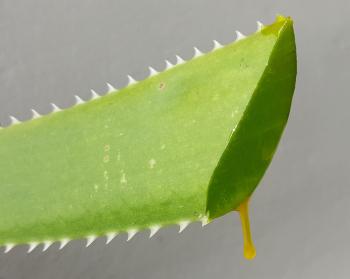
Aloe succotrina, which is one of over 100 species of aloe listed on the IUCN red data list, occurring in southern Africa, was the first South African aloe to be grown in Europe. In 1689, it flowered while being grown in Europe, and in 1691, an illustration of Aloe succotrina appeared in Plukenet’s Phytographia. A description of the plant was given in Johan Commelin’s Horti medici Amstelodamensis 1: 91, 2, t. 48 (1697), in which Aloe succotrina’s yellow bitter sap with its more pleasant smell, in comparison to the sap of the ‘the true aloe’, presumably Aloe vera, was mentioned. Though it was collected at the Cape and grown in Europe, Oldenland, the superintendant of the Dutch East India Company’s garden in 1695, never included it amongst the species of aloe grown at the Cape.
Ecology
Ecology
Aloe succotrina is pollinated by nectar feeding birds, such as the Orange Breasted, Double Collared and Malachite Sunbirds. These birds have long, curved beaks which fit into the long aloe flowers perfectly.
Thanks to their succulent leaves, aloes are adapted to survival in arid conditions and are capable of surviving long periods of drought. Some aloes such as Aloe succotrina, occur in fire-prone areas, but they survive by growing in fire-protected habitats, such as rocky outcrops where the fire is not as severe. Aloe succotrina also retains its old leaves, which dry out around the stem, and this acts as an insulator against the heat of a fire.
Aloes contain a bitter leaf sap and have sharp thorns on the edges of the leaves which help to deter animals from foraging the leaves.
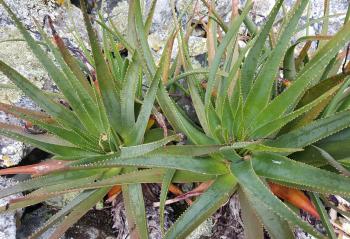
Uses
Use
For hundreds of years, aloes have been used for medicinal and cosmetic purposes, although there are no records for this aloe being used as a medicine. Aloe succotrina leaves have been used to produce a royal purple-coloured dye.
Aloe succotrina is used in gardens to attract birds. It also does well as a container plant or in a rockery, and it grows well in coastal, strandveld and sea-front gardens.
Growing Aloe succotrina
Grow
Aloe succotrina thrives in fynbos gardens, and the best time of the year to plant in the garden, is in March or April, at the start of, or during the rainy season. This will allow young new plants a chance to establish themselves before the warmer summer months and is more water-wise, especially with the water restrictions placed on South African gardens.
Grow Aloe succotrina in a well-drained sandy soil, in a sunny area in the garden or an area that receives semi-shade. It is well suited to rockeries. It needs to be given enough space, as it divides and forms dense clusters of up to 2 m in diameter. In order for it to grow well, it should be fed with compost annually. This plant does not do well in the summer rainfall region or in rich soils and needs to be protected from frost.
When propagating Aloe succotrina, one can do so using sexual or vegetative propagation. Plants propagated vegetatively will reach maturity far more quickly than plants grown from seed. If grown from seed, plants will begin to flower after 3 to 4 years. Propagating plants from seed is very useful in ensuring the survival of some rare species of aloe.
In spring or summer, sow fresh seed in a shallow seed tray, using a soil mixture of 2 parts sand: 1 part soil: 1 part sieved compost. Once the seeds are sown, they need to be covered with a 1 to 2 mm layer of sand. The medium is to be kept moist. It takes up to 3 weeks for germination to occur. Seeds may be pre-treated with a systemic fungicide or, treated regularly with a fungicidal spray once seedlings have germinated, to prevent seedling from developing soft rot. After a year, once seedlings are large enough, they should be planted out into pots.
Aloe succotrina is propagated from stem cuttings or offshoots. The stem cuttings are removed from the mother plant and left to dry out for 2 weeks. The wound is dusted with sulphur which helps to prevent fungal infection from setting into the wound and the use of a rooting hormone powder will help with the rooting of the cutting. Aloe succotrina can be propagated in this way at any time of the year, but it is advisable to take the cuttings after flowering, in September or October. The plants will root and be ready to be planted out by April the following year.
Once the cuttings have dried out after 2 weeks and have been dusted with a rooting hormone, the stems are to be planted into a potting mix consisting of 3 (milled and composted) pine bark: 4 sand: 2 compost. Taking cuttings in September or October is also beneficial to the mother plant as after flowering, it will begin to grow vegetatively and push out new shoots. If cuttings were to be taken during the winter months, an open wound would be more susceptible to rot.
Aloe succotrina, like most plants, is prone to a variety of pests and diseases that will spoil their leaves. The worst pest is aloe snout beetle. It tunnels into the crown of the plant where it lays its eggs. The larvae tunnel through the stems and the plant starts to rot. If discovered in time, the larvae and the weevil can be removed and the crown cleaned out and killed by hand. Due to damage often being detected when it is already too late, a systemic pesticide may need to be used when infestation levels are too high.
References
- Bean, A. & Johns, A. 2005. Stellenbosch to Hermanus South African wild flower guide 5. Botanical Society of South Africa, Cape Town.
- Hull, E. 2016. Conversation. Propagating and growing Aloe succotrina. 22 August.
- Jackson, B. 1971. A glossary of botanic terms. Hafner Publishing, New York.
- Jeppe, B. 1969. South African aloes. Purnell, Cape Town.
- Klopper, R. & Smith, G. 2010. Aloe L. PlantZAfrica. http://pza.sanbi.org/aloe-genus accessed 24 November 2016
- Manning, J. 2007. Field guide to Fynbos. Struik Publishers, Cape Town.
- Reynolds, G.W. 1950. The aloes of South Africa. Trustees of the Aloes of South Africa Book Fund, Johannesburg.
- Smith, C.A. 1966. Common names of South African plants. Memoirs of the Botanical Survey of South Africa No. 35. Government Printer, Pretoria.
- Smith, G.F. & Van Wyk, B. 2008. Aloes in southern Africa. Struik, Cape Town.
- Van Wyk, B.-E. & Gericke, N. 2000. People's plants . Briza Publications, Pretoria.
- Foden, W. & Potter, L. 2009. Aloe succotrina Lam. National Assessment: Red List of South African Plants version 2015.1. Accessed on 2016/11/24
- Van Wyk, B. & Smith, G.F. 2014. Guide to the aloes of South Africa. Briza Publications, Pretoria.
Credits
Ernst van Jaarsveld
Kirstenbosch National Botanical Garden
18 June 2001
Updated and expanded by Karen Wall
Harold Porter National Botanical Garden
19 December 2016
Plant Attributes:
Plant Type: Shrub, Succulent
SA Distribution: Western Cape
Soil type: Sandy
Flowering season: Winter
PH: Acid
Flower colour: Green, Red, Orange
Aspect: Full Sun, Morning Sun (Semi Shade), Afternoon Sun (Semi Shade)
Gardening skill: Average
Special Features:
Horticultural zones







Rate this article
Article well written and informative
Rate this plant
Is this an interesting plant?
Login to add your Comment
Back to topNot registered yet? Click here to register.